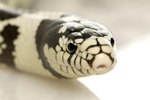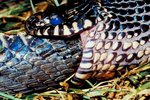
The name "black cobra" refers to snakes in the naja naja family of cobras, which are also called Indian cobras, spectacled cobras and Pakistani cobras. Although these cobras are renowned for their potentially fatal venom, 90 percent of all strikes on humans are dry bites -- harmless warnings to stay away from these deadly but timid snakes. Black cobras are not endangered, and are common throughout India, Pakistan, Bangladesh, Nepal and Bhutan.
Physical Description
Cobras are best known for the hood they flare when they feel threatened or are about to strike. Black cobras are not necessarily black, and may also be olive-gray or any shade of brown. The back of their hood displays a distinctive white or pale yellow spectacled pattern. These cobras grow 6 to 8 feet in length, becoming medium-sized adult snakes with smooth patterned scales.
Habitat and Diet
Black cobras have no fixed habitat. They follow their prey, feeding on mice, rats, reptiles and poultry wherever they may be found. Although these timid snakes shy away from human contact, they frequently enter barns and homes in search of food. The black cobra strikes quickly once it has isolated its prey. The snake then waits while its venom paralyzes the animal, often killing it, before swallowing it whole.
Behavior
The diurnal cobra is most active in the evening and early morning hours. Quick and agile, it will do its best to avoid humans, but can be hostile when provoked or agitated. When threatened, the black cobra raises the front third of its body, elongating its neck and flaring its skin to display its intimidating hood. If the threat continues despite the snake’s warning, its attack will be swift. Black cobras attack at full strength to defend themselves. They will hold on and gnaw at their victim, and may strike repeatedly.
Reproduction
Black cobras breed primarily from April through July. The female lays between 12 and 20 eggs and stays with them until they hatch, guarding them through the incubation period. After around 50 days, the eggs start to hatch. The hatchlings are venomous from the moment they free themselves from their eggs, and are capable of rearing up and striking from birth.
Importance to Humans
Black cobras are one of the most revered and highly worshiped snakes in Indian and Hindu mythology. They eat rats, mice and other creatures people consider unwanted pests. Their venom has been used by American pharmaceutical companies in pain-killing medications. Research conducted by the Drug Development Division of the India Institute of Chemical Biology in 2007 concluded that proteins found in the venom of black cobras and other snakes can be used in effective anti-cancer treatments.
References
- University of Michigan Museum of Zoology: Animal Diversity Web: Naja Naja
- Wildlife of Pakistan: Snakes of Pakistan: Spectacles of Indian Cobra, Black Pakistan Cobra, Central Asian/Oxus or Brown Cobra
- Toronto Zoo: Explore the Zoo: Spectacled Cobra
- Daiiji World: Spectacled Indian Cobra
- Express India: Cobra Venom Can Provide Cure for Cancer
- FactZoo.com: Indian Cobra aka Black, Spectacled, Pakistani Cobra
Photo Credits
-
Jupiterimages/Photos.com/Getty Images
Writer Bio
Jennifer Mueller began writing and editing professionally in 1995, when she became sports editor of her university's newspaper while also writing a bi-monthly general interest column for an independent tourist publication. Mueller holds a Bachelor of Arts in political science from the University of North Carolina at Asheville and a Juris Doctor from Indiana University Maurer School of Law.


